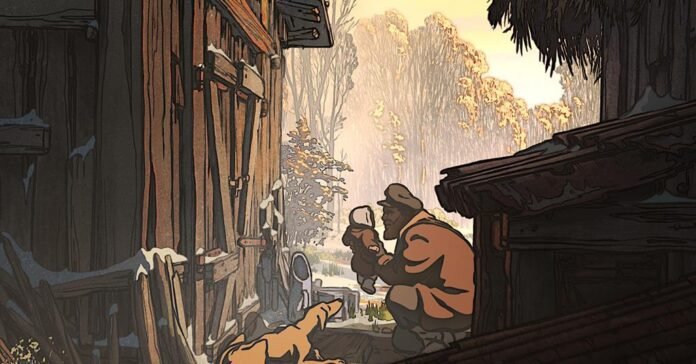Dir. Michel Hazanavicius. France 2024. 81mins
Michel Hazanavicius’s The Most Valuable of Cargoes is an odd animated departure for a director best-known for silent-era pastiche The Artist, and comedies together with 2022’s creaky Cannes-opening zombie remake Remaining Reduce. His Competitors entry is predicated on a 2019 ebook by French writer Jean-Claude Grumberg, a few woodcutter and his spouse who rescue an toddler towards the backdrop of the Holocaust. Voice-over narration from the late Jean-Louis Trintignant) begins, “As soon as upon a time…” earlier than warning us that this gained’t be a fairy story of the soppy Tom Thumb selection. But, its preciousness may very well be a turn-off for grownup viewers, whereas youthful audiences will discover a lot of the fabric each too twee and too grimly disturbing to attach with.
By no means finds an acceptable register for addressing this most painful of themes
Given the persistence of Holocaust denial, it’s all the extra important that movies in regards to the Shoah proceed to be made – however with the utmost moral and aesthetic rigour. The truth that Hazanavicius’ movie is supremely well-intentioned, and executed with creative magnificence, solely makes it all of the extra obvious a misstep. But the director’s status as a mainstream draw, at the very least in France (the place it releases on November 20), ought to present home leverage, and a few festivals and retailers might favour the movie for its accessible instructional dimension.
Set in a snowbound forest in a time and place we quickly guess to be Poland through the Second World Warfare, the story is about an impoverished, childless, late middle-aged couple, identified solely because the Woodcutter and the Woodcutter’s Spouse (voiced with gravitas by Dominique Blanc and the dependably gruff Grégory Gadebois). Typically the Spouse will stroll by the snow to look at a passing practice, which she worships as a god, praying that it’ll carry her much-needed bounty. The bitter irony is that we all know what she doesn’t – that the practice is carrying Jewish prisoners to Auschwitz.
At some point, nevertheless, the car does carry an providing – a bundle thrown into the snow, which proves to be a child. We later study that the kid, a lady from a pair of twins, has been dropped fromthe practice by her father, determined for any likelihood to avoid wasting her life. The Spouse takes the kid dwelling and decides to nurture her – however will get a hostile response from her husband, who guesses that this is likely one of the ‘accursed’ race he calls ‘the Heartless’.
Raging and ogre-like, the Woodcutter is within the grip of a virulently superstitious, medieval model of anti-semitism. However the child’s harmless smiles and blissful gurgling work their magical impact, and the Woodcutter begins listening to its heartbeat resounding in every part from logs to spoons. His personal coronary heart thawed, he finds himself reluctant to hitch in with the anti-semitic toasts of his workmates – sparking harmful suspicions amongst them.
Within the movie’s favour, it’s not afraid of telling bitter truths about violence, hatred and loss of life. Some key characters meet brutal ends, and the scenes on the practice carrying the newborn’s household have a genuinely harrowing energy that holds again from sentiment, partly due to the stark execution of the character animation (underneath the aegis of Julien Grande, from the director’s personal sketches). However different moments are appallingly misjudged – such because the sudden minimize from a bleak dramatic second to a close-up of two floppy-eared rabbits within the woods.
The worst determination is available in a late sequence exhibiting nonetheless, stylised black and white pictures of the faces of the Auschwitz useless: hellish visions which might be crassly coercive of their try to elicit surprised horror. There’s a distinction between the graphic illustration of such pictures in documentary and their ornamental amplification right here – in sharp distinction with these movies, notably final yr’s Competitors standout The Zone of Curiosity, which have reminded us of the creative energy, and the moral decency, of not exhibiting.
The movie is definitely executed with experience: the animation makes use of muted colors and thick, weighty outlines and a broad palette of textures for the character pictures, together with gentle by dense forest. Much less convincing is Alexandre Desplat’s florid rating, intermittently laced with folksy touches of conventional klezmer (and topped with an incongruously bouncy Yiddish tune over the top credit). It, just like the movie itself, by no means finds an acceptable register for addressing this most painful of themes.
Manufacturing firm: Agat Movies/Ex Nihilo, Les Compagnons du Cinéma
Worldwide gross sales: Studio Canal chloe.marquet@studiocanal.com
Producers: Patrick Sobelman, Florence Gastaud, Michel Hazanavicius
Screenplay: Michel Hazanavicius, Jean-Claude Grumberg, primarily based on the ebook by Jean-Claude Grumberg
Enhancing: Michel Hazanavicius, Laurent-Pelé Piovanni
Creative course: Julien Grande
Music: Alexandre Desplat
Essential voice solid: Dominique Blanc, Grégory Gadebois, Denis Podalydès, Jean-Louis Trintignant
